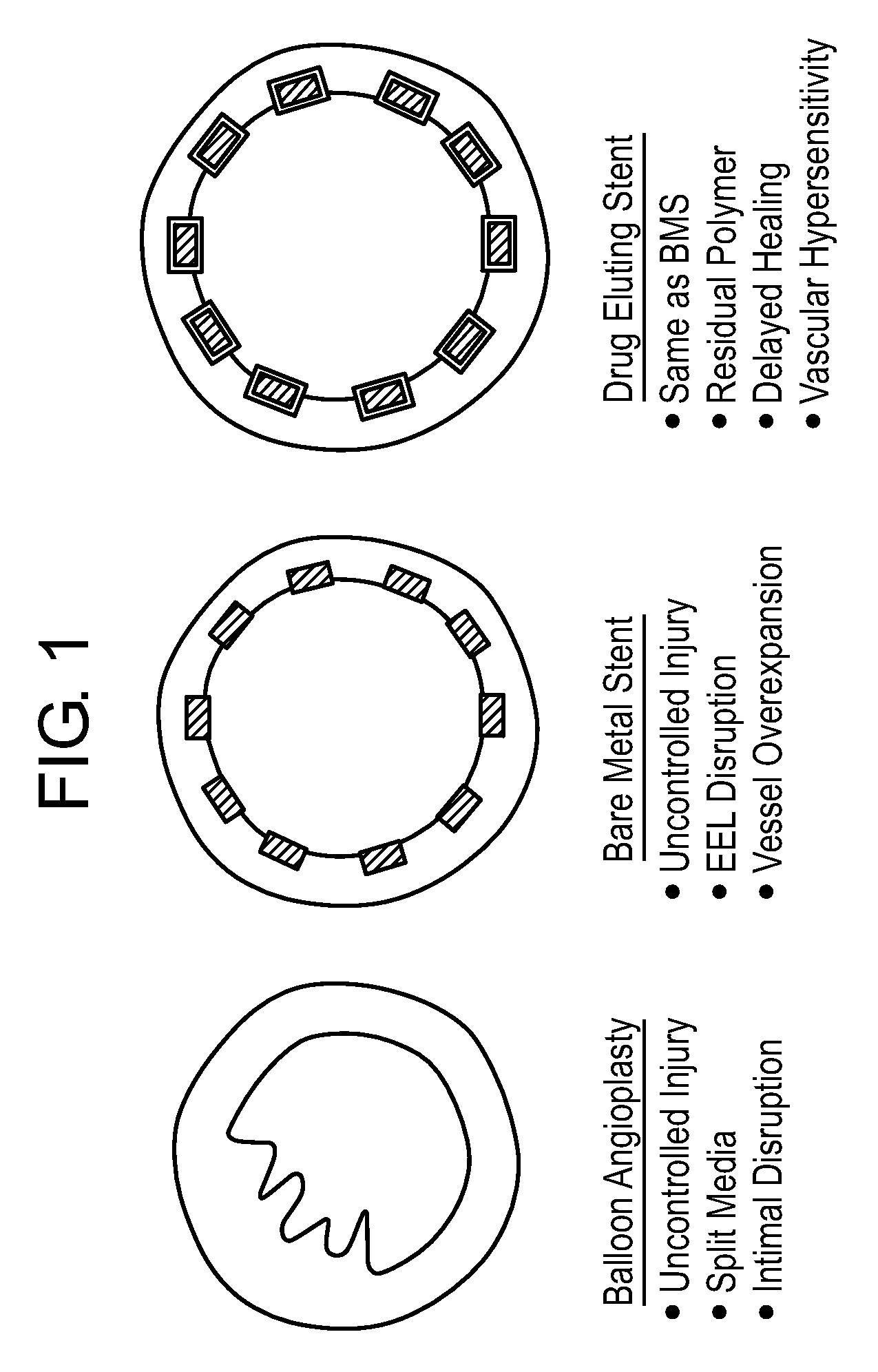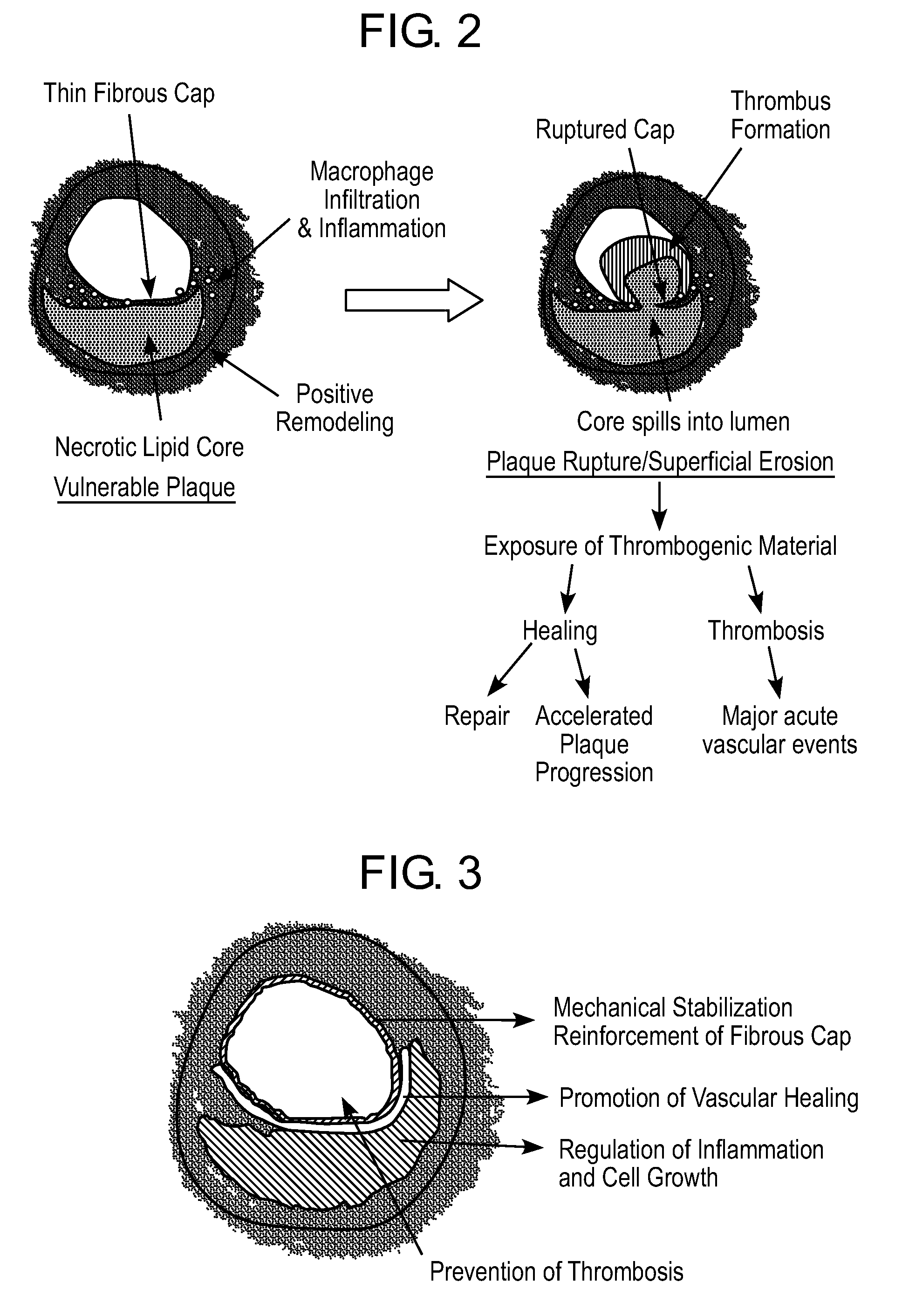Composite Vascular Prosthesis
a vascular prosthesis and composite technology, applied in the field of composite vascular prosthesis, can solve the problems of high restnosis rate, high recoil of the vessel, abrupt closure, etc., and achieve the effect of increasing the injury rate of the vessel
- Summary
- Abstract
- Description
- Claims
- Application Information
AI Technical Summary
Benefits of technology
Problems solved by technology
Method used
Image
Examples
example 1
[0053]In one embodiment, the matrix can include a structural material, a bioadhesive component and a bioactive component. The structural material is composed of a metallic alloy or a durable or bioabsorbable polymer that has very thin strut thickness and width is highly flexible and conforms to the vessel wall. The bioadhesive component is composed of one or several natural proteins resembling extracellular matrix proteins, mainly collagen or collagen derivates. This component is preferentially located on the outer abluminal surface of the device. The bioactive component is achieved through direct modification of the interior adluminal surface of the prosthesis. In a preferred embodiment, the adluminal surface modification is the application of an etched surface topography tailored for improved endothelial cell migration, growth, adhesion and maturation. In an alternate embodiment, the adluminal layer is a deposited surface coating for achieving the same purpose. Other combinations ...
example 2
[0054]In another embodiment, the bioadhesive layer can act as the structural layer of the device. In this embodiment, the mixture of proteins must provide the structural support for the device. Blends of proteins such as collagen and elastin can be coupled with other compounds. These proteins can be assembled together to form tubes or preformed sheets that can be apposed to the vessel in-situ by an expandable delivery system such as a low-pressure balloon catheter. The bioadhesive component is deposited onto the external abluminal surface of the device to allow anchoring and apposition of the prosthesis to the vessel wall. This component will be preferentially located in the outer surface of the device but could be located throughout the entire surface of it
[0055]In a further derivation from the embodiments described above, the bioadhesive component incorporates molecules to allow bioactivation via secondary mechanism. These molecules could be incorporated via nanoliposomes, nanopar...
example 3
[0092]The structural layer or skeleton may be an ultra-thin self-expandable Nitinol alloy with a specific configuration in which the skeleton is covered by a thin bioadhesive component. In a preferred embodiment, this bioadhesive component includes or is composed of collagen. The layer may have a thickness of from 400 nm to 120 microns (enough to reinforce the thickness of the thinned fibrous cap). The average fiber size may be 100 to 800 nm and the average porosity size is preferably from 1 to 20 microns, enough to allow cell seeding and protein incorporation. The collagen layer may have a degradation time of less than 2 weeks, reaching 50% degradation in less than 4 days. In this embodiment, the coating may be disposed around the struts (all surfaces) or can cover only the abluminal side of the prosthesis. In a preferred variation, the inner surface of the device is modified to allow endothelial cell adhesion and colonization. This biological process is achieved by either directly...
PUM
 Login to View More
Login to View More Abstract
Description
Claims
Application Information
 Login to View More
Login to View More - R&D
- Intellectual Property
- Life Sciences
- Materials
- Tech Scout
- Unparalleled Data Quality
- Higher Quality Content
- 60% Fewer Hallucinations
Browse by: Latest US Patents, China's latest patents, Technical Efficacy Thesaurus, Application Domain, Technology Topic, Popular Technical Reports.
© 2025 PatSnap. All rights reserved.Legal|Privacy policy|Modern Slavery Act Transparency Statement|Sitemap|About US| Contact US: help@patsnap.com



